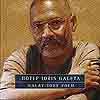This is part two of pianist-composer-educator Hotep Idris Galeta’s capsule chronicle of the history of jazz in South Africa. Many agree, and Hotep confirms, that South Africa is arguably blessed with the broadest, richest history of jazz musicians and jazz expression this side of the music’s country of origin. Last time (scroll down) Hotep left off with the destruction of the early jazz-powered dance hall scene in Sophiatown at the time of the draconian apartheid laws which destroyed several previously multi-racial communities in SA in favor of the enforced township exile of black citizens.
Part 2: THE DEVELOPMENT OF JAZZ IN SOUTH AFRICA
by Hotep Idris Galeta
Cover of Hotep’s Malay Tone Poem release (Sheer Sound)

The 1950’s are remembered as the days of passive resistance against the Nationalist government’s institutionalized racism, but it is also remembered as a great age of Jazz development in South Africa. A new strain of Jazz began to emerge which contained a greater American influence. This new strain was the result of the Bebop revolution in the U.S. Young emergent musicians such as Dollar Brand [later known as Abdullah Ibrahim], Chris McGregor, Johnny Gertse, Sammy Moritz, Makaya Ntoshoko Mra “Cristopher Columbus†Ngcukana, Jonas Gwangwa, Jimmy Adams, Early Mabuza, “Cups and Saucers†Nkanuka, Hugh Masekela, Kippie Moeketsie, Henry February, Anthony and Richard Schilder, Harold Japhta and this writer included took to this new exciting Jazz form from America like ducks to water.
The real milestone occurred when one of my future mentors to be, visiting American pianist and Jazz educator John Mehegan came to South Africa in the late 50’s on an American State Department sponsored tour. After the tour he assembled a local group to record an album for Gallo Records entitled “Jazz in Africaâ€. Beside Mehegan on piano the group consisted of Hugh Masekela on Trumpet, Jonas Gwangwa on Trombone, Kiepie Moeketsie on Alto Saxophone, Gene Latimore on Drums and Claude Shange on Bass. When Mehegan departed for the U.S. Dollar Brand added Johnny Gertse on Bass and Makaya Ntoshoko on Drums, creating a new rhythm section to which he added Masekela, Gwangwa and Moeketsie, calling this new band “The Jazz Epistles†One of the most dynamic and creative bands of the late 50’s. The band recorded two albums “The Jazz Epistles Vol. 1 and Vol. 2†played a few gigs around the country and disbanded when Masekela and Gwangwa left to study in the U.S. in 1960.
That unfortunately was the end of the line for that kind of American Jazz in South Africa. Many of the musicians who played it left the country because of the increasingly repressive political situation, this writer included. With the advent of the Avant Garde in the 60’s the “Blue Notes†led by Eastern Cape born pianist Chris McGregor together with saxophonist Dudu Pukwane, trumpeter Mongezi Feza, bassist Johnny Mbizo Dyani and drummer Louis Tebogo Moholo took up the banner and propelled the music in a new direction. They also had to leave the country but made a huge impact upon the European and British jazz scene with their fiery brand of South African Avant Garde Jazz. It is only Louis Tebogo Moholo that is alive today. The rest of them all died in exile before they could experience the freedom of democracy in the land of their birth. Many stayed and continued to produce creative music in a political environment that became increasingly oppressive and brutal.
In the province of the Western Cape in the city of Cape Town musicians such as Basil “Mannenberg†Coetzee, Robbie Jansen, Paul Abrahams, Chris Schilder, Gilbert Matthews, and many others too numerous to mention gave their commitment, time and creativity to the struggle for democracy. They used South African Jazz as a platform and became deeply involved in the struggle for democracy on a creative level using their music as a clarion call for liberation at United Democratic Front political rallies in the townships.
Today in a democratic South Africa jazz is thriving in an environment of freedom and racial reconciliation. At present there exists an up and coming core of extremely masterful young musicians, both black and white. Some of them are graduates from tertiary institutions here in South Africa with vibrant jazz education programs and some come from community jazz education programs. Gloria Bosman, Judith Sephuma, Melanie Scholtz, Zim Ngqawana, Kevin Gibson, Andile Yenana, Lulu Gontsana, Mark Fransman , Eddie Jooste, Buddy Wells, Paul Hamner, Keshivan Naidoo, Dominic Peters , Andre Petersen, Victor Masondo, Marcus Wyatt, Herbie Tshoali, Themba Mkize and the late Moses Taiwa Molelekwa. These are just a few of some of the new innovative core of younger South African musicians who are responsible for taking the music into a new creative direction. Their vision and innovative approaches is creating a significant impact upon the South African jazz scene by the development of new concepts and ideas within the South African jazz genre. This bodes extremely well for the development of jazz in South African which like in Nazi Germany some sixty odd years ago had been suppressed and stifled during the turbulent apartheid era.
Copyright: by Hotep Idris Galeta

5 Responses to The Development of Jazz in South Africa – Pt. 2